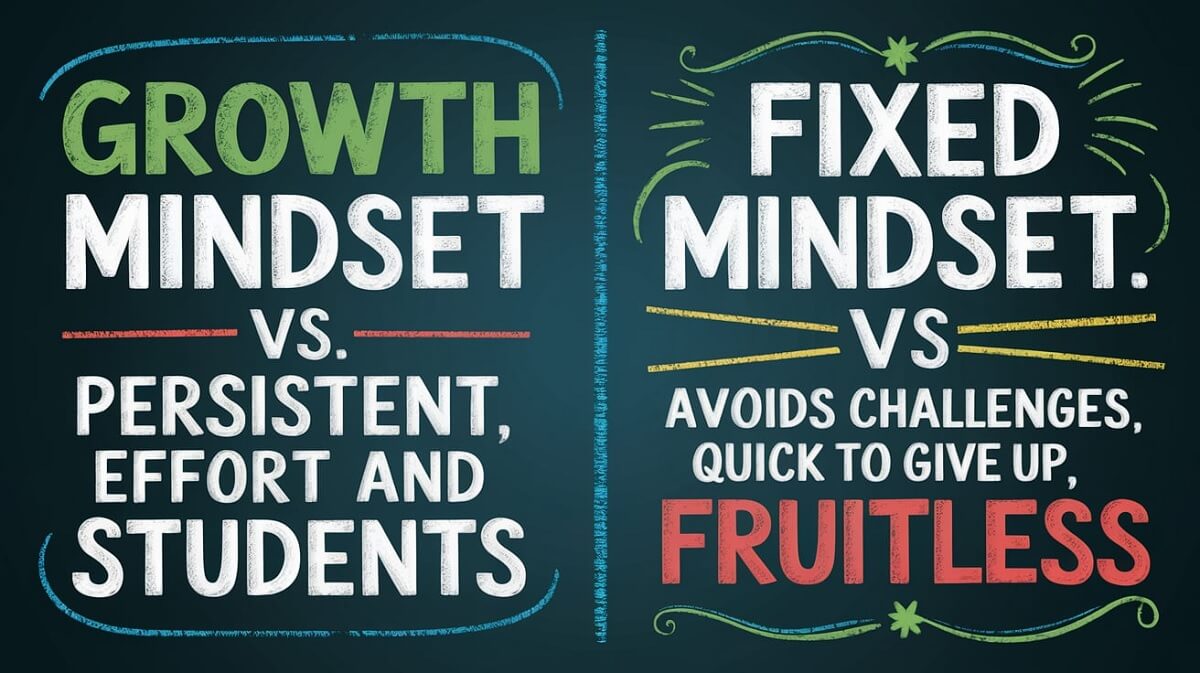
The Importance of Building a Growth Mindset
A growth mindset is the belief that your abilities develop through practice, useful strategies, and honest feedback. Talent still matters, yet it does not set a hard limit. This belief changes how you handle mistakes, how you plan your effort, and how you respond when work feels tough. You shift from “I can’t do this” to “I can learn this with a better method and more practice.”
Learners and professionals who adopt this view treat errors as information. They review what went wrong, select a new tactic, and try again. Parents, teachers, and managers play a role here. The way we speak about effort, progress, and skill growth shapes what students and teams attempt next.
Table of Content
- The Importance of Building a Growth Mindset
- Fixed vs Growth: What Changes in Daily Practice
- What Research Suggests
- Benefits Across Study, Work, and Life
- When Growth Mindset Works Best
- Principles for Teaching and Coaching
- Practical Steps for Students and Candidates
- Practical Steps for Teachers and Trainers
- Practical Steps for Parents and Mentors
- Routines and Scripts You Can Use Today
- Measuring Progress Without Pressure
- Common Pitfalls and How to Avoid Them
- Ethics, Inclusion, and Fair Practice
- Key Takeaways
- Conclusion
- FAQs
Fixed vs Growth: What Changes in Daily Practice

Beliefs and self-talk
A fixed view says ability is set. A growth view says ability grows with the right tools and time. You can hear the difference in daily self-talk. A fixed message says, “I’m not good at this.” A growth message says, “I’m not there yet—what will I try next?”
Response to difficulty
Fixed beliefs push people to avoid challenge and hide struggle. Growth beliefs nudge people to seek feedback, test alternatives, and use errors to improve. The second path is slower at first, then stronger later, since each attempt adds to the skill base.
Praise and motivation
Feedback that labels the person (“You’re a natural”) can create fear of mistakes. Feedback that targets the process (“Your outline clarified the argument—now improve the evidence”) builds motivation and direction. Learners move from chasing approval to building craft.
What Research Suggests
Across many settings, learners who hold growth beliefs tend to select harder tasks, stay with them longer, and use feedback more often. Short, well-timed lessons that explain how the brain adapts, combined with coaching on study methods, have helped students who started behind. Large school datasets across countries link growth beliefs with stronger scores and lower test anxiety for many students, though the size of the link varies by system.
Meta-analyses that combine many studies report small average gains in grades from mindset lessons alone. Gains rise when the message is matched with strong instruction, clear goals, and practice that stretches skill. The pattern is clear: belief helps, design matters, climate matters.

Benefits Across Study, Work, and Life
Learning and study
With a growth mindset, you spend less time protecting your image and more time learning. You keep challenge in the weekly plan, build a study routine that favors recall over rereading, and review mistakes without shame. Grades and retention improve when this mindset sits beside sound methods.
Motivation and resilience
Growth beliefs support long-term motivation. You track effort in a concrete way, not as hours clocked but as strategies tested and refined. Resilience becomes a routine—notice a problem, choose a fix, try again—rather than a slogan.
Teams and workplaces
Teams thrive when leaders praise strategy quality, document lessons learned, and treat missteps as a chance to refine process. Hiring signals matter too. When managers reward learning and sharing, staff members take thoughtful risks, surface issues early, and improve the work.
When Growth Mindset Works Best
Who benefits most
Students with lower prior achievement often gain the most when they receive a short, credible mindset lesson linked to upcoming challenges and supported by teachers who share clear routines. High achievers can benefit as well, especially when new levels of difficulty arrive and strategy upgrades become necessary.
Timing and design
Timing matters. Introduce a brief lesson near a known challenge—new unit, exam season, or transition to a higher course. Link the message directly to actions students can take that week. Reinforce it through feedback, revision windows, and time set aside for reflection.
Pair with instruction and metacognition
Mindset by itself is not a plan. Pair the lesson with explicit teaching on how to learn: retrieval practice, spaced review, worked examples, and self-explanation. Add metacognitive prompts so learners plan, monitor, and adjust between attempts.
Principles for Teaching and Coaching
Keep the message precise
Growth mindset is not “try harder.” It is “try smarter.” Tie effort to method and method to results. Praise the match between task and tactic. Name the change you want to see in the next draft or the next attempt.
Make progress visible
Progress motivates. Use simple charts, checklists, or portfolios that show early attempts, feedback, and revisions. When learners see skill building on the page, they stay engaged.
Share authority
Invite learners to suggest strategies, set small goals, and reflect on outcomes. When they help design the path, they stick with it longer and learn from it more deeply.
Practical Steps for Students and Candidates
Build weekly habits
-
Goal: Pick one skill to improve this week.
-
Method: Choose a tactic that fits the skill—retrieval questions, spaced review, or a worked example.
-
Practice: Schedule two short sessions and one longer review.
-
Review: After each session, write one sentence on what changed and one next step.
Replace labels with process
-
Swap: “I’m bad at physics” → “I will solve three practice items and write one error fix per item.”
-
Swap: “I can’t write intros” → “I will draft two openings and test them with a peer checklist.”
Ask for actionable feedback
-
Prompt: “Which part should I fix first?”
-
Prompt: “What change would raise clarity the most?”
-
Prompt: “Where did my method break and how can I repair it?”
Use an error log
-
Field label: Error type:
-
Field label: Cause:
-
Field label: Fix I will try:
-
Field label: Date I will retest:
Keep it short and review it each week. The goal is not perfection. The goal is fewer repeat errors.
Practical Steps for Teachers and Trainers
Shape classroom talk
Switch from person praise to process feedback. Name the tactic that worked and the next change to try. Over time, students internalize this language and begin to coach themselves with the same clarity.
Design for revision
Plan one cycle of redo for major tasks. Offer a short window to apply feedback and resubmit. Connect marks to growth so students see value in reworking.
Teach learning strategies directly
Spend a few minutes modeling how to use retrieval practice, spaced review, and worked examples. Give students a simple template: question, attempt, check, explain. Keep it routine so it becomes habit.
Use brief mindset lessons wisely
If you run a mindset session, keep it short, credible, and linked to the next unit. Move from belief to method in the same week. Document one strategy change per learner and revisit it after the assessment.
Practical Steps for Parents and Mentors
Shift praise and questions
Swap labels for questions that guide process:
-
“What step made the biggest difference?”
-
“What will you try next time?”
-
“Which part should get your attention first?”
Normalize productive struggle
Share a story about a time you revised, sought feedback, and improved. Young people watch how adults handle mistakes. When they see calm problem solving, they mirror it.
Create a calm study rhythm
Set a regular study window with short breaks, a quiet space, and clear start cues. Short and steady beats long and rare. Praise the habit, not the identity.
Routines and Scripts You Can Use Today
Two-minute strategy spotlight (end of lesson)
-
Field label: What worked today:
-
Field label: Where it helped:
-
Field label: One tweak for next time:
Invite a few students to share. Keep it quick.
Favorite error wall
Students post a common error with a short fix. Rotate items weekly. Treat it like a learning gallery, not a list of failures.
Peer review with a process frame
Give partners a simple script:
-
Field label: What I saw you try:
-
Field label: Evidence it helped:
-
Field label: One next step to test:
Manager 1:1 “experiment next week”
-
Field label: Goal for this week:
-
Field label: Method to test:
-
Field label: How we will check impact:
-
Field label: Date to review together:
Measuring Progress Without Pressure
Choose metrics that guide action
Track inputs you can control and outputs that show learning:
-
Inputs: retrieval sessions, revision count, strategy variety.
-
Outputs: accuracy on target question types, clarity scores on rubrics, fewer repeat errors.
Review often and keep it short
A five-minute weekly review keeps focus on what works. Use the same format each time so attention stays on learning, not on the tool.
Share results with care
Celebrate specific changes in method and the results that followed. Avoid rank talk that shames students or teams. Growth is personal and steady, not loud.
Common Pitfalls and How to Avoid Them
Slogans without support
Posters and slogans do little on their own. Learners need time, tactics, and feedback. Tie every message to a concrete action.
Effort without strategy
Long hours without a plan will not move results. Help learners select a method that fits the task and set a short test window for it.
One-off workshops
Single events fade fast. Build small routines into weekly work—strategy spotlights, redo windows, and brief reflection prompts.
Ignoring context
Mindset helps, yet access, instruction quality, and safety to fail still shape outcomes. Pair mindset with fair grading, clear criteria, and timely help.
Ethics, Inclusion, and Fair Practice
Respect the learner
Use language that protects dignity. Feedback should be honest and kind. Direct comments to the work, not the person. Invite questions without judgment.
Share the platform
Include student voice in setting goals and choosing tactics. Ask what helps and what gets in the way. Adapt routines so they fit local needs and resources.
Avoid blame
Do not use mindset talk to explain away gaps caused by limited resources or unclear teaching. Keep focus on supports that actually raise learning.
Keep records transparent
If you collect data, tell learners what you track and why. Use the data to coach, not to label. Review growth with the learner, not about the learner.
Key Takeaways
-
Growth mindset means linking effort to smart methods and honest feedback.
-
Short, credible lessons work best when linked to immediate tasks and backed by strong instruction.
-
Progress grows when learners plan, test, and review strategies each week.
-
Classrooms and teams improve when feedback targets process quality, not identity.
-
Equity stays central: pair mindset with access, clarity, and support.
Conclusion
Your mindset influences what you attempt, how you practice, and how you react when work gets tough. When learners, families, teachers, and teams adopt clear routines—process feedback, revision windows, simple metrics—skills grow. Start with one change this week. Pick a method that fits your goal, try it, and reflect on the result. Repeat. Small cycles add up.
FAQs
How do I explain growth mindset to a child in simple terms?
Say that the brain builds skill like a muscle builds strength. Practice, feedback, and good tactics help it grow. Share one short story from your day that shows how you learned something hard.
What is one study habit that reflects a growth mindset?
Use retrieval practice. Write three questions on a topic, answer from memory, check your work, and fix one error. Repeat later with new questions.
How can teachers use mindset without adding extra workload?
Add tiny routines: a two-minute strategy spotlight, a short redo window, and a weekly reflection line on what changed. These fit inside current lessons.
Does growth mindset help in the workplace?
Yes. Teams benefit when managers praise strategy quality and ask for small experiments. Staff learn faster, share lessons, and reduce repeat mistakes.
How can parents support without adding pressure?
Ask about process, not identity. Use questions like “Which step helped?” and “What will you try next?” Praise steady habits and small improvements.
Personal Development

